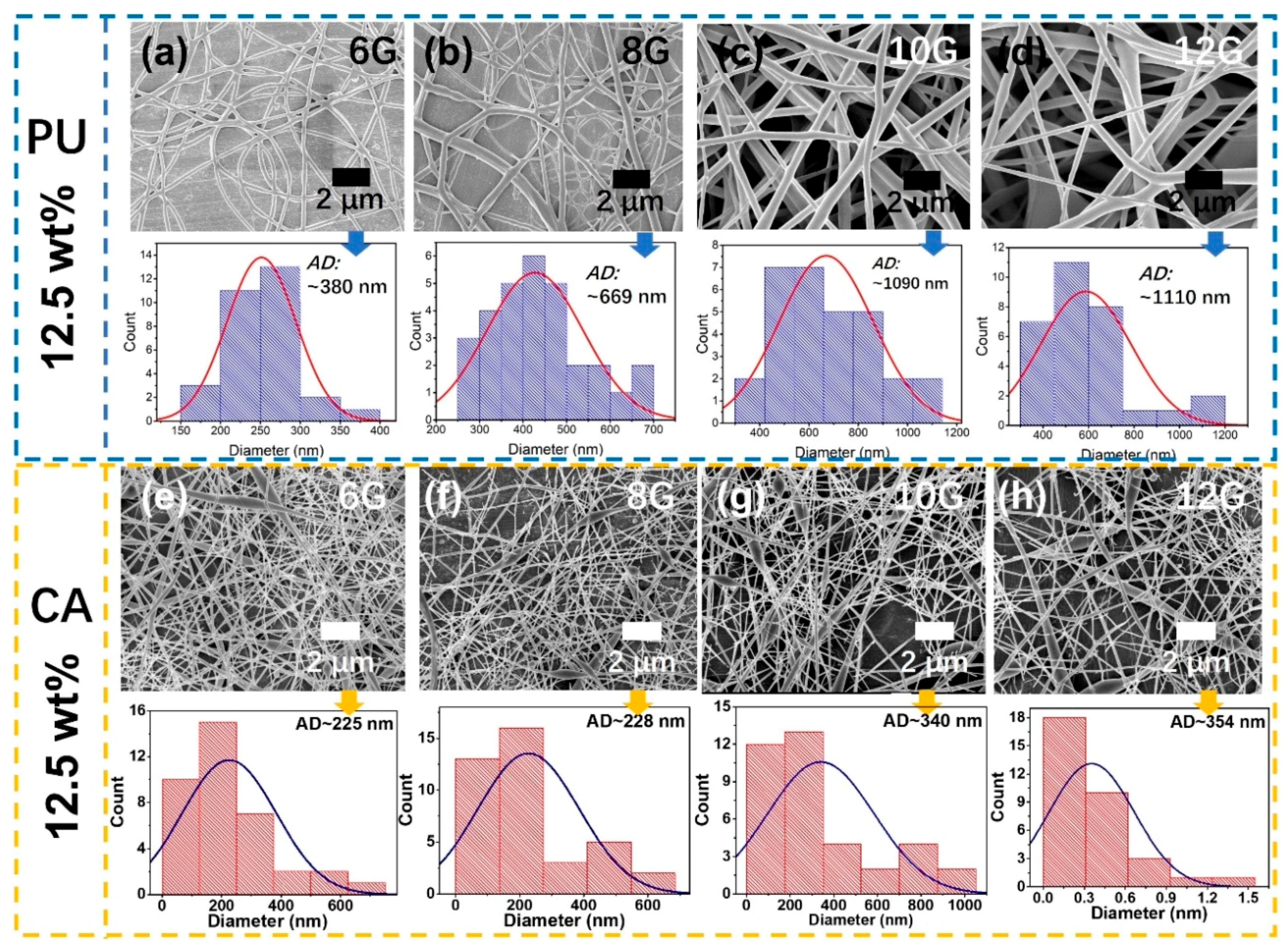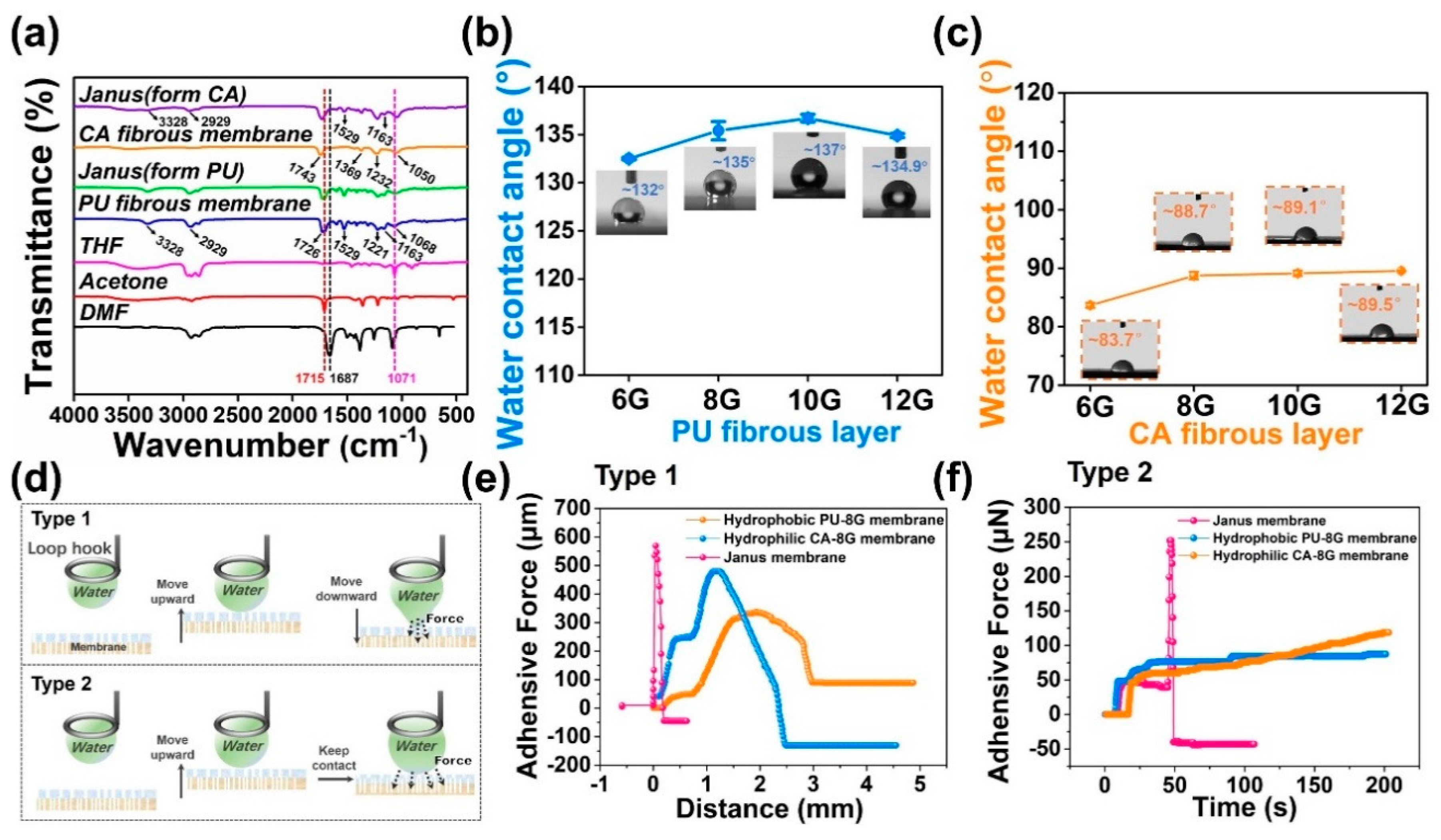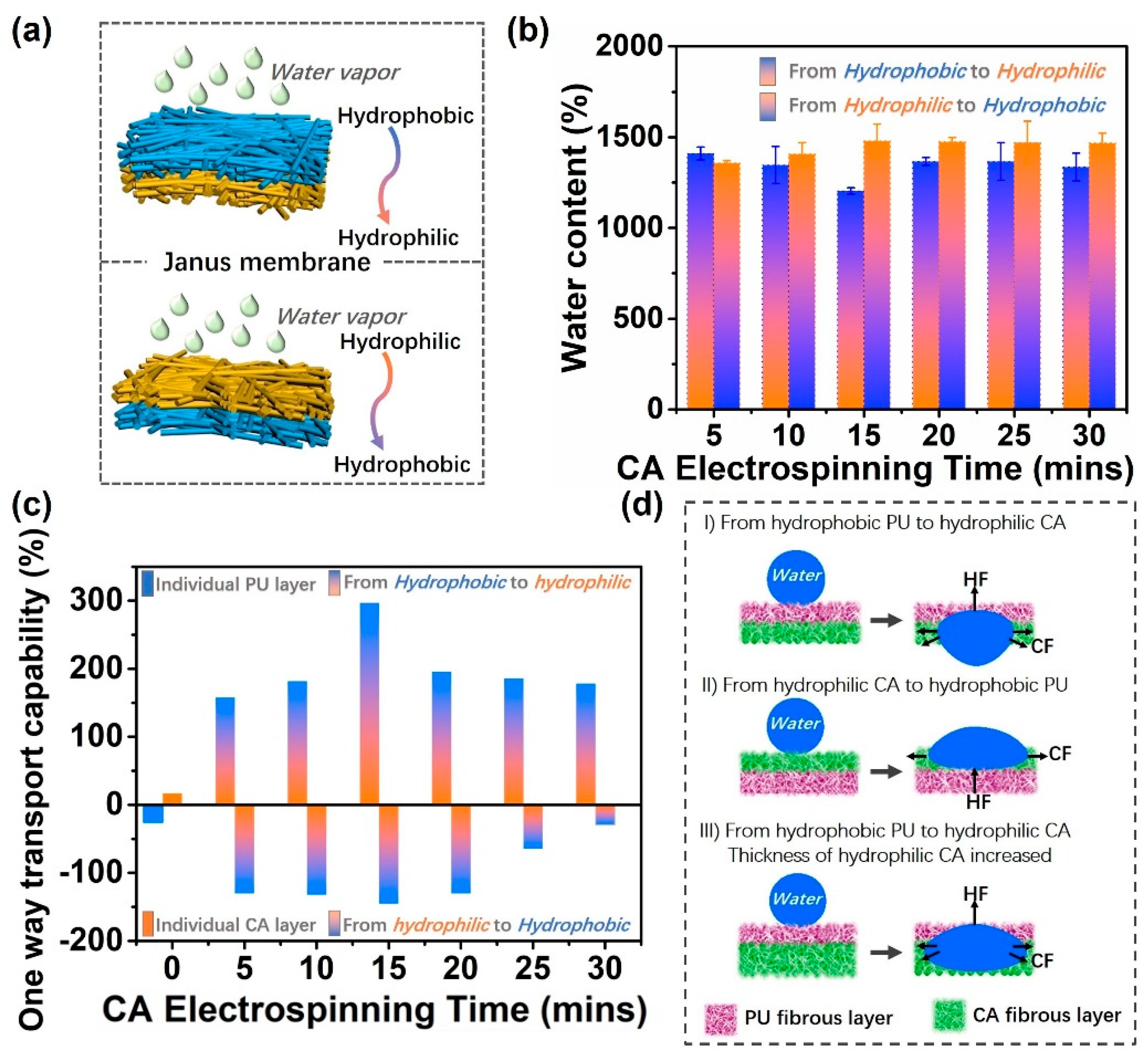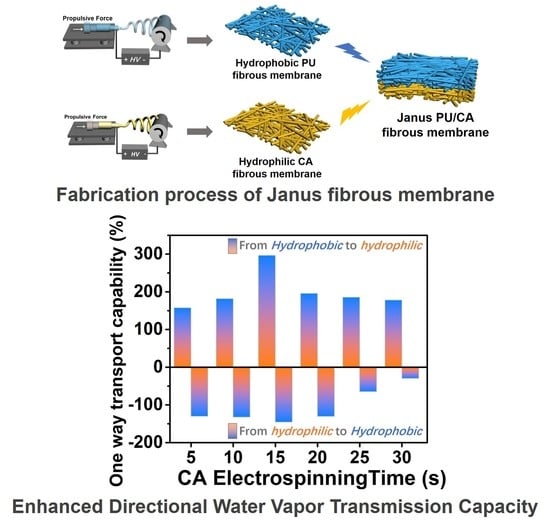Novel Janus Fibrous Membranes with Enhanced Directional Water Vapor Transmission
Abstract
:1. Introduction
2. Materials and Methods
2.1. Materials
2.2. Preparation of the Moisture-Penetrability Janus Membranes
2.3. Instruments and Characterization
3. Results and Discussion
3.1. Fabrication and Morphology of Polyurethane (PU)/Cellulose Acetate (CA) Janus Fibrous Membrane
3.2. Chemical Characterization and Wettability of As-Prepared Membranes
3.3. Enhanced Directional Water Vapor Transmission Capability
4. Conclusions
Author Contributions
Funding
Conflicts of Interest
References
- Wu, J.; Zhou, H.; Wang, H.X.; Shao, H.; Yan, G.L.; Lin, T. Novel Water Harvesting Fibrous Membranes with Directional Water Transport Capability. Adv. Mater. Interfaces 2019, 6, 1801529. [Google Scholar] [CrossRef]
- Zhang, S.; Huang, J.; Chen, Z.; Lai, Y. Bioinspired Special Wettability Surfaces: From Fundamental Research to Water Harvesting Applications. Small 2017, 13, 1602992. [Google Scholar] [CrossRef] [PubMed]
- Bai, H.; Sun, R.; Ju, J.; Yao, X.; Zheng, Y.; Jiang, L. Large-Scale Fabrication of Bioinspired Fibers for Directional Water Collection. Small 2011, 7, 3429–3433. [Google Scholar] [CrossRef] [PubMed]
- Cao, M.; Xiao, J.; Yu, C.; Li, K.; Jiang, L. Hydrophobic/Hydrophilic Cooperative Janus System for Enhancement of Fog Collection. Small 2015, 11, 4379–4384. [Google Scholar] [CrossRef] [PubMed]
- Zhao, Y.; Wang, H.; Zhou, H.; Lin, T. Directional Fluid Transport in Thin Porous Materials and its Functional Applications. Small 2017, 13, 1601070. [Google Scholar] [CrossRef] [PubMed]
- Dong, Y.; Thomas, N.L.; Lu, X. Electrospun Dual-Layer Mats with Covalently Bonded Zno Nanoparticles for Moisture Wicking and Antibacterial Textiles. Mater. Des. 2017, 134, 54–63. [Google Scholar] [CrossRef]
- Babar, A.A.; Miao, D.Y.; Ali, N.; Zhao, J.; Wang, X.F.; Yu, J.Y.; Ding, B. Breathable and Colorful Cellulose Acetate-Based Nanofibrous Membranes for Directional Moisture Transport. ACS Appl. Mater. Interfaces 2018, 10, 22866–22875. [Google Scholar] [CrossRef]
- Parker, A.R.; Lawrence, C.R. Water capture by a desert beetle. Nature 2001, 414, 33–34. [Google Scholar] [CrossRef]
- Nørgaard, T.; Dacke, M. Fog-basking behaviour and water collection efficiency in Namib Desert Darkling beetles. Front. Zool. 2010, 7, 1–8. [Google Scholar] [CrossRef]
- Gans, C.; Merlin, R.; Blumer, W.F.C. The water-collecting mechanism of Moloch horridus re-examined. Amphib.-Reptil. 1982, 3, 57–64. [Google Scholar]
- Comanns, P.; Effertz, C.; Hischen, F.; Staudt, K.; Böhme, W.; Baumgartner, W. Moisture harvesting and water transport through specialized micro-structures on the integument of lizards. Beilstein J. Nanotechnol. 2011, 2, 204–214. [Google Scholar] [CrossRef] [Green Version]
- Zheng, Y.; Bai, H.; Huang, Z.; Tian, X.; Nie, F.Q.; Zhao, Y.; Zhai, J.; Jiang, L. Directional water collection on wetted spider silk. Nature 2010, 463, 640–643. [Google Scholar] [CrossRef]
- Geng, H.; Bai, H.; Fan, Y.; Wang, S.; Ba, T.; Yu, C.; Cao, M.; Jiang, L. Unidirectional water delivery on a superhydrophilic surface two-dimensional asymmetrical wettability barriers. Mater. Horiz. 2018, 5, 303–308. [Google Scholar] [CrossRef]
- Pang, C.; Kim, S.M.; Rahmawan, Y.; Suh, K.-Y. Beetle-inspired bidirectional, asymmetric interlocking using geometry-tunable nanohairs. ACS Appl. Mater. Interfaces 2012, 4, 4225–4230. [Google Scholar] [CrossRef]
- Wu, J.; Zhang, L.; Wang, Y.; Wang, P. Efficient and Anisotropic Fog Harvesting on a hybrid and directional surface. Adv. Mater. Interfaces 2017, 4, 1600801. [Google Scholar] [CrossRef]
- Chen, Y.; Wang, L.; Xue, Y.; Jiang, L.; Zheng, Y. Bioinspired tilt-angle Fabricated structure gradient fibers: Micro-drops fast transport in a long-distance. Sci. Rep. 2013, 3, 2927–2934. [Google Scholar] [CrossRef]
- Xue, Y.; Chen, Y.; Wang, T.; Jiang, L.; Zheng, Y. Directional Size-Triggered Microdroplet Target Transport on Gradient-Step Fibers. J. Mater. Chem. A 2014, 2, 7156–7160. [Google Scholar] [CrossRef]
- Wang, H.; Ding, J.; Dai, L.; Wang, X.; Lin, T. Directional water-transfer through fabrics induced by asymmetric wettability. J. Mater. Chem. 2010, 20, 7938–7940. [Google Scholar] [CrossRef] [Green Version]
- Zhou, H.; Wang, H.; Niu, H.; Lin, T. Superphobicity/philicity Janus Fabrics with Switchable, Spontaneous, Directional Transport Ability to Water and Oil Fluids. Sci. Rep. 2013, 3, 2964–2968. [Google Scholar] [CrossRef]
- Wu, J.; Wang, N.; Wang, L.; Dong, H.; Zhao, Y.; Jiang, L. Unidirectional water-penetration composite fibrous film via electrospinning. Soft Matter 2012, 8, 5996–5999. [Google Scholar] [CrossRef]
- Tian, X.; Li, J.; Wang, X. Anisotropic liquid penetration arising from a cross-sectional wettability gradient. Soft Matter 2012, 8, 2633–2637. [Google Scholar] [CrossRef]
- Cao, M.; Li, K.; Dong, Z.; Yu, C.; Yang, S.; Song, C.; Liu, K.; Jiang, L. Superhydrophobic “Pump”: Continuous and spontaneous antigravity water delivery. Adv. Funct. Mater. 2015, 25, 4114–4119. [Google Scholar] [CrossRef]
- Nazir, A.; Hussain, T.; Abbas, G.; Ahmed, A. Effect of design and method of creating wicking channels on moisture management and air permeability of cotton fabrics. J. Nat. Fibers 2015, 12, 232–242. [Google Scholar] [CrossRef]
- Yang, H.-C.; Hou, J.; Chen, V.; Xu, Z.-K. Janus Membranes: Exploring Duality for Advanced Separation. Angew. Chem. Int. Ed. 2016, 55, 13398–13407. [Google Scholar] [CrossRef]
- Zuo, G.; Wang, R. Novel membrane surface modification to enhance anti-oil fouling property for membrane distillation application. J. Membr. Sci. 2013, 447, 26–35. [Google Scholar] [CrossRef]
- Zhou, H.; Guo, Z. Superwetting Janus membranes: Focusing on unidirectional transport behaviors and multiple applications. J. Mater. Chem. A 2019, 7, 12921–12950. [Google Scholar] [CrossRef]
- Chew, N.G.P.; Zhao, S.; Malde, C.; Wang, R. Polyvinylidene fluoride membrane modification via oxidant-induced dopamine polymerization for sustainable direct-contact membrane distillation. J. Membr. Sci. 2018, 563, 31–42. [Google Scholar] [CrossRef]
- Yang, H.-C.; Xie, Y.; Hou, J.; Cheetham, A.K.; Chen, V.; Darling, S.B. Janus Membranes: Creating Asymmetry for Energy Efficiency. Adv. Mater. 2018, 30, 1801495. [Google Scholar] [CrossRef]
- Chew, N.G.P.; Zhang, Y.; Goh, K.; Ho, J.S.; Xu, R.; Wang, R. Hierarchically Structured Janus Membrane Surfaces for Enhanced Membrane Distillation Performance. ACS Appl. Mater. Interfaces 2019, 11, 25524–25534. [Google Scholar] [CrossRef]
- Bai, H.; Ju, J.; Zheng, Y.; Jiang, L. Functional fibers: Functional Fibers with Unique Wettability Inspired by Spider Silks. Adv. Mater. 2012, 24, 2786–2791. [Google Scholar] [CrossRef]
- Wu, J.; Wang, N.; Zhao, Y.; Wang, L.; Dong, H.; Zhao, Y.; Jiang, L. Electrospun porous structure fibrous film with high oil adsorption capacity. ACS Appl. Mater. Interfaces 2012, 4, 3207–3212. [Google Scholar] [CrossRef]
- Mokhtar, N.M.; Lau, W.J.; Ismail, A.F.; Ng, B.C. Physicochemical study of polyvinylidene fluoride-Cloisite15A composite membranes for membrane distillation application. RSC Adv. 2014, 4, 63367–63379. [Google Scholar] [CrossRef]
- Tsilomelekis, G.; Josephson, T.R.; Nikolakis, V.; Caratzoulas, S. Origin of 5-Hydroxymethylfurfural Stability in Water/Dimethyl Sulfoxide Mixtures. ChemSusChem 2014, 7, 117–126. [Google Scholar] [CrossRef]
- Sabrina, A.; Fabiano, B.S.; Arnaldo, F.S.; Ieda, S.S.; Roy, E.B. Infrared spectral evidence and DFT calculations of hydrogen-bonding and molecular structures of acetogenins. J. Mol. Struct. 2017, 1130, 174–180. [Google Scholar]
- Jadhav, D.L.; Karthick, N.K.; Kannan, P.P.; Shanmugam, R.; Elangovan, A.; Arivazhagan, G. Molecular interaction forces in acetone + ethanol binary liquid solutions: FTIR and theoretical studies. J. Mol. Struct. 2017, 1130, 497–502. [Google Scholar] [CrossRef]
- Son, W.K.; Youk, J.H.; Lee, T.S.; Park, W.H. Electrospinning of ultrafine cellulose acetate fibers: Studies of a new solvent system and deacetylation of ultrafine cellulose acetate fibers. J. Polym. Sci. Polym. Phys. 2004, 42, 5–11. [Google Scholar] [CrossRef]
- Ertas, Y.; Uyar, T. Fabrication of cellulose acetate/polybenzoxazine cross-linked electrospun nanofibrous membrane for water treatment. Carbohyd. Polym. 2017, 177, 378–387. [Google Scholar] [CrossRef]
- Guo, Z.; Tang, G.; Zhou, Y.; Liu, S.; Hou, H.; Chen, Z.; Chen, J.; Hu, C.; Wang, F.; Smedt, S.C.D.; et al. Fabrication of Sustained-release CA-PU Coaxial Electrospun Fiber Membranes for Plant Grafting Application. Carbohydr. Polym. 2017, 169, 198–205. [Google Scholar] [CrossRef]
- Gabriel, L.P.; Rodrigues, A.A.; Macedo, M.; Jardini, A.L.; Filho, R.M. Electrospun polyurethane membranes for Tissue Engineering applications. Mater. Sci. Eng. C Mater. 2017, 72, 113–117. [Google Scholar] [CrossRef]
- Zeng, C.; Wang, H.; Zhou, H.; Lin, T. Directional Water Transport Fabrics with Durable Ultra-High One-Way Transport Capacity. Adv. Mater. Interfaces 2016, 3, 1600036. [Google Scholar] [CrossRef]
- Babar, A.A.; Wang, X.; Iqbal, N.; Yu, J.; Ding, B. Tailoring Differential Moisture Transfer Performance of Nonwoven/Polyacrylonitrile-SiO2 Nanofiber Composite Membranes. Adv. Mater. Interfaces 2017, 4, 1700062. [Google Scholar] [CrossRef]
- Miao, D.; Huang, Z.; Wang, X.; Yu, J.; Ding, B. Continuous, Spontaneous, and Directional Water Transport in the Trilayered Fibrous Membranes for Functional Moisture Wicking Textiles. Small 2018, 14, 1801527. [Google Scholar] [CrossRef]
- Wang, X.; Huang, Z.; Miao, D.; Zhao, J.; Yu, J.; Ding, B. Biomimetic Fibrous Murray Membranes with Ultrafast Water Transport and Evaporation for Smart Moisture-Wicking Fabrics. ACS Nano 2019, 13, 1060–1070. [Google Scholar] [CrossRef]






© 2019 by the authors. Licensee MDPI, Basel, Switzerland. This article is an open access article distributed under the terms and conditions of the Creative Commons Attribution (CC BY) license (http://creativecommons.org/licenses/by/4.0/).
Share and Cite
Tang, S.; Pi, H.; Zhang, Y.; Wu, J.; Zhang, X. Novel Janus Fibrous Membranes with Enhanced Directional Water Vapor Transmission. Appl. Sci. 2019, 9, 3302. https://doi.org/10.3390/app9163302
Tang S, Pi H, Zhang Y, Wu J, Zhang X. Novel Janus Fibrous Membranes with Enhanced Directional Water Vapor Transmission. Applied Sciences. 2019; 9(16):3302. https://doi.org/10.3390/app9163302
Chicago/Turabian StyleTang, Shengnan, Haohong Pi, Yingying Zhang, Jing Wu, and Xiuqin Zhang. 2019. "Novel Janus Fibrous Membranes with Enhanced Directional Water Vapor Transmission" Applied Sciences 9, no. 16: 3302. https://doi.org/10.3390/app9163302
APA StyleTang, S., Pi, H., Zhang, Y., Wu, J., & Zhang, X. (2019). Novel Janus Fibrous Membranes with Enhanced Directional Water Vapor Transmission. Applied Sciences, 9(16), 3302. https://doi.org/10.3390/app9163302





